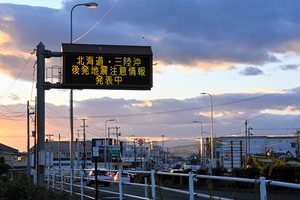By LISA VOGT/ Special to Asahi Weekly
March 22, 2022 at 07:00 JST
Oh, my! Good gracious, my Lord, I never expected ... . Wowee!” I was at a loss for words when I set eyes upon the Oya stone quarry.
When folks in the Kanto region think of Tochigi Prefecture, I think for most, a couple of things come to mind: Nikko’s dazzling gold-and-red Toshogu (Tokugawa Ieyasu’s mausoleum), the magnificent Kegon waterfall and Utsunomiya with its reputation for being a district where a whole lot of gyoza dumplings are consumed.
This place, Oya, definitely needs to be added to the list.
I pulled into the big, crowded parking lot in front of the Oya History Museum. There were at least five or six parking attendants directing traffic with red batons. I made a mental check that they could easily charge for parking, but it was complimentary: a good first impression.
Upon entering the subterranean stone quarry, I noticed an immediate drop in temperature. As my eyes adjusted to the dim light, the sheer size and beauty of the cavern were overwhelming. The Oya stone mine covers over 20,000 square meters, or about three soccer fields, in scope.
Oya stone is a soft yet durable volcanic rock composed of various minerals, each with a different hardness. It has been utilized in many famous structures, most notably the facade of Frank Lloyd Wright’s Imperial Hotel. Skilled craftsmen carved the stone by hand, calculating the placement of soft brown spots called “miso” when creating the pieces.
Records show Oya stones have been mined here for an astonishing 1,500 years. There are displays that show how stone blocks were painfully cut out one by one with pickaxes in the early days.
During World War II, the mine was used as a secret underground base by Nakajima Aircraft Co. (Subaru Corp. today) to manufacture Zero fighter planes. The occupation forces discovered its existence after the war.
Today the caverns are artfully lit up, and the old quarry is used for concerts, events, commercial shoots, art installations and even as a wedding chapel.
Nearby is Oya Kannon, a thousand-armed goddess of mercy made from Oya stone and believed to have been commissioned by the monk Kobo Daishi and carved by Afghan monks in the year 810. You read that right. Afghan monks in Japan? According to the temple’s website, yes.
Oya is Japan’s Sedona for those spiritually inclined folks who know what I mean. People have dwelled here since the Jomon Pottery Culture Period, 11,000 years ago. Visit, and you won’t be disappointed. Your world will be rocked.
* * *
This article by Lisa Vogt, a Washington-born and Tokyo-based photographer, originally appeared in the Feb. 20 issue of Asahi Weekly. It is part of the series "Lisa’s Wanderings Around Japan," which depicts various places across the country through the perspective of the author, a professor at Meiji University.




















A peek through the music industry’s curtain at the producers who harnessed social media to help their idols go global.
A series based on diplomatic documents declassified by Japan’s Foreign Ministry
Here is a collection of first-hand accounts by “hibakusha” atomic bomb survivors.
Cooking experts, chefs and others involved in the field of food introduce their special recipes intertwined with their paths in life.
A series about Japanese-Americans and their memories of World War II